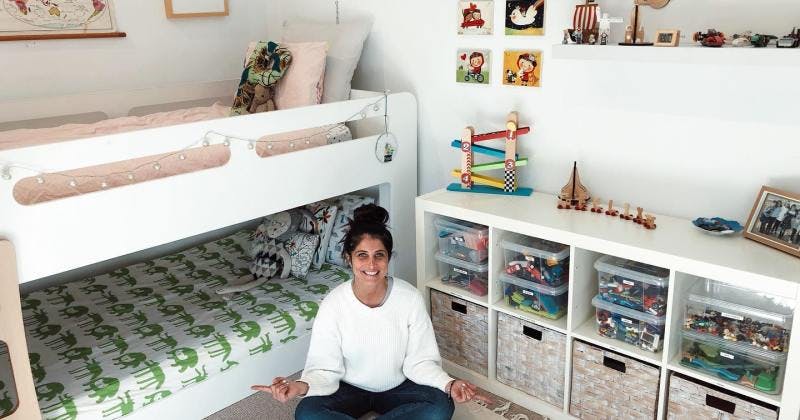Decluttering tips and tricks from an organising superhero
Last updated on Sunday, February 28, 2021 | By Craig Gibson

Overwhelmed by the sheer amount of stuff you have? Dread opening your wardrobe/cupboard/pantry or kid’s bedroom door? Is your garage a ‘no-go’ zone?
If you answered yes to any of these it is likely you have a clutter or ‘stuff’ problem.
For some much needed direction and HELP we touched base with decluttering superhero and organising expert Anita of Mise en Place. She works with her clients to bring sanity to everything from wardrobes and pantries to cupboards, kids bedrooms and even entire homes.
[ml]

Decluttering superhero and organising expert Anita of Mise en Place
I was in real estate, and truth be told I was bad at the selling part, but got more excited by the visual outcome of getting a home ready for sale than the actual selling. After I had children the lifestyle of an agent didn’t really fit with what I wanted from life, so becoming a mum was the perfect time to reinvent myself while still contributing to our household. So I Googled what I had started doing – decluttering and helping people become organised – and found the term: professional organiser or organising expert. It was a real ‘ah ha’ moment! I then started finding clients by word of mouth and via Facebook groups.
I have now been doing this for seven and a half years and I really love my job. It’s given me real balance in my life and I get to help people!
[youtube]cSbvNxNDxBU[/youtube]
Overall my approach is tough, realistic but light-hearted. You have to be honest with people and if you want to truly help them. People often don’t realise that you only use 20 per cent of what you own – so 80 per cent of your stuff is never or rarely used. I can tell just from scanning what is in a wardrobe what is worn and unused.
I take the time to understand a person, get a feel for their life and how their home operates, and who interacts in it. You have to earn their trust and realise that you are accessing a very personal space.
I then help them put a system in place, by setting up a timeline and priorities – which empowers them to own the process.

People generally have problems with 2 – 3 zones in their home, where they dread going into a room or even opening the door. The most common problem areas are kid’s toys, wardrobes and pantry, followed by the kitchen and garage. Others come to me and say they want help with their whole home.
Most families have too many toys. But what many well-meaning parents don’t understand is, in reality, more toys equals less play. Kids are easily overwhelmed with choice, and a child who is unsure of what to play with often ends up playing with nothing at all. More and more families are taking the minimalist approach to toys, cutting back on the clutter and focusing on quality over quantity.
For younger kids under the age of 5 you should declutter without them as they are not old enough to make these decisions. Otherwise you should look to label all their stuff which will make storage easier. Also show them what you have done when you are finished, so they know where everything is, but also so they can help keep it that way.
For teens they really need an organised study space that reduces distractions. You also need to pick your battles with this age group – it’s all about small wins!

[ml][ol][li indent=0 align=left]Always declutter before organising. People often make the mistake of buying storage before sorting through all their stuff, which makes no sense.[/li][li indent=0 align=left]Start small, like with your bedside table or undie draw or break larger tasks down into smaller jobs. It has to be achievable otherwise it can overwhelm and demotivate you.[/li][li indent=0 align=left]Be realistic with timeframes. A garage will take 2 days, with the first day dedicated to declutter and the second to organizing. For a wardrobe you need to budget 6-8 hours. [/li][/ol][/ml]

In terms of physical products that can help you get organised, these three can really help you make a start:
[ml][ol][li indent=0 align=left]Label maker: this can help you separate and organise things at the beginning.[/li][li indent=0 align=left]Sorting boxes: clear boxes in the 10L – 52L size range are perfect for organised storage.[/li][li indent=0 align=left]Donation area: keep a bag or box in a handy accessible place so you can drop things in to take to a charity/donation centre.[/li][/ol][/ml]
Serious hoarders actually have a mental health issue. It is essentially an unrealistic attachment to things, where the risk to losing these things is greater than the healthy and safety of their home.
If you answered yes to any of these it is likely you have a clutter or ‘stuff’ problem.
For some much needed direction and HELP we touched base with decluttering superhero and organising expert Anita of Mise en Place. She works with her clients to bring sanity to everything from wardrobes and pantries to cupboards, kids bedrooms and even entire homes.
Key takeaways
[ml]
- [li indent=0 align=left]Always declutter before organising[/li][li indent=0 align=left]Make each step achievable to avoid overwhelm[/li][li indent=0 align=left]Be realistic with timeframes and remember being organised takes time![/li]

Decluttering superhero and organising expert Anita of Mise en Place
Tell us about yourself and how you came to be a decluttering and organising expert?
I was in real estate, and truth be told I was bad at the selling part, but got more excited by the visual outcome of getting a home ready for sale than the actual selling. After I had children the lifestyle of an agent didn’t really fit with what I wanted from life, so becoming a mum was the perfect time to reinvent myself while still contributing to our household. So I Googled what I had started doing – decluttering and helping people become organised – and found the term: professional organiser or organising expert. It was a real ‘ah ha’ moment! I then started finding clients by word of mouth and via Facebook groups.
I have now been doing this for seven and a half years and I really love my job. It’s given me real balance in my life and I get to help people!
[youtube]cSbvNxNDxBU[/youtube]
How do you approach working with a client?
Overall my approach is tough, realistic but light-hearted. You have to be honest with people and if you want to truly help them. People often don’t realise that you only use 20 per cent of what you own – so 80 per cent of your stuff is never or rarely used. I can tell just from scanning what is in a wardrobe what is worn and unused.
I take the time to understand a person, get a feel for their life and how their home operates, and who interacts in it. You have to earn their trust and realise that you are accessing a very personal space.
I then help them put a system in place, by setting up a timeline and priorities – which empowers them to own the process.

What are some of the most common problems clients come to you with?
People generally have problems with 2 – 3 zones in their home, where they dread going into a room or even opening the door. The most common problem areas are kid’s toys, wardrobes and pantry, followed by the kitchen and garage. Others come to me and say they want help with their whole home.
Kids pose a unique problem, how do you deal with toys and their bedrooms?
Most families have too many toys. But what many well-meaning parents don’t understand is, in reality, more toys equals less play. Kids are easily overwhelmed with choice, and a child who is unsure of what to play with often ends up playing with nothing at all. More and more families are taking the minimalist approach to toys, cutting back on the clutter and focusing on quality over quantity.
For younger kids under the age of 5 you should declutter without them as they are not old enough to make these decisions. Otherwise you should look to label all their stuff which will make storage easier. Also show them what you have done when you are finished, so they know where everything is, but also so they can help keep it that way.
For teens they really need an organised study space that reduces distractions. You also need to pick your battles with this age group – it’s all about small wins!

What three easy decluttering tips can you share with us today?
[ml][ol][li indent=0 align=left]Always declutter before organising. People often make the mistake of buying storage before sorting through all their stuff, which makes no sense.[/li][li indent=0 align=left]Start small, like with your bedside table or undie draw or break larger tasks down into smaller jobs. It has to be achievable otherwise it can overwhelm and demotivate you.[/li][li indent=0 align=left]Be realistic with timeframes. A garage will take 2 days, with the first day dedicated to declutter and the second to organizing. For a wardrobe you need to budget 6-8 hours. [/li][/ol][/ml]

Share with us your top 3 organising solutions
In terms of physical products that can help you get organised, these three can really help you make a start:
[ml][ol][li indent=0 align=left]Label maker: this can help you separate and organise things at the beginning.[/li][li indent=0 align=left]Sorting boxes: clear boxes in the 10L – 52L size range are perfect for organised storage.[/li][li indent=0 align=left]Donation area: keep a bag or box in a handy accessible place so you can drop things in to take to a charity/donation centre.[/li][/ol][/ml]
Lastly, what is the psychology behind hoarding?
Serious hoarders actually have a mental health issue. It is essentially an unrealistic attachment to things, where the risk to losing these things is greater than the healthy and safety of their home.


